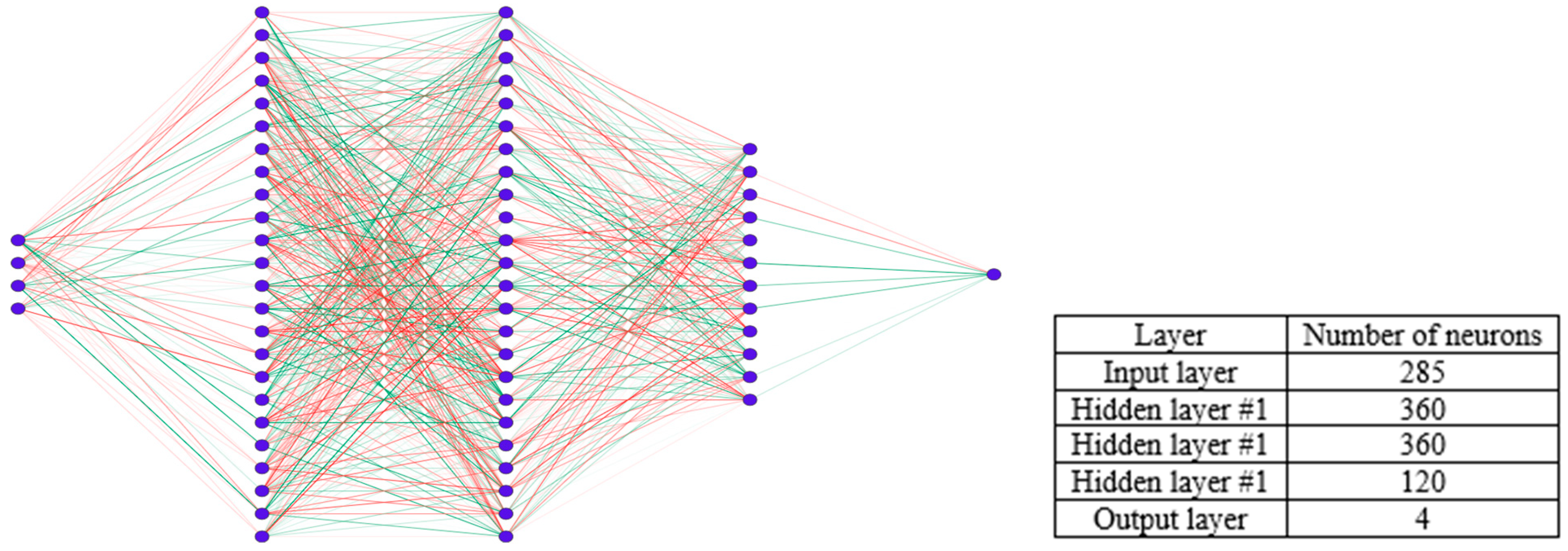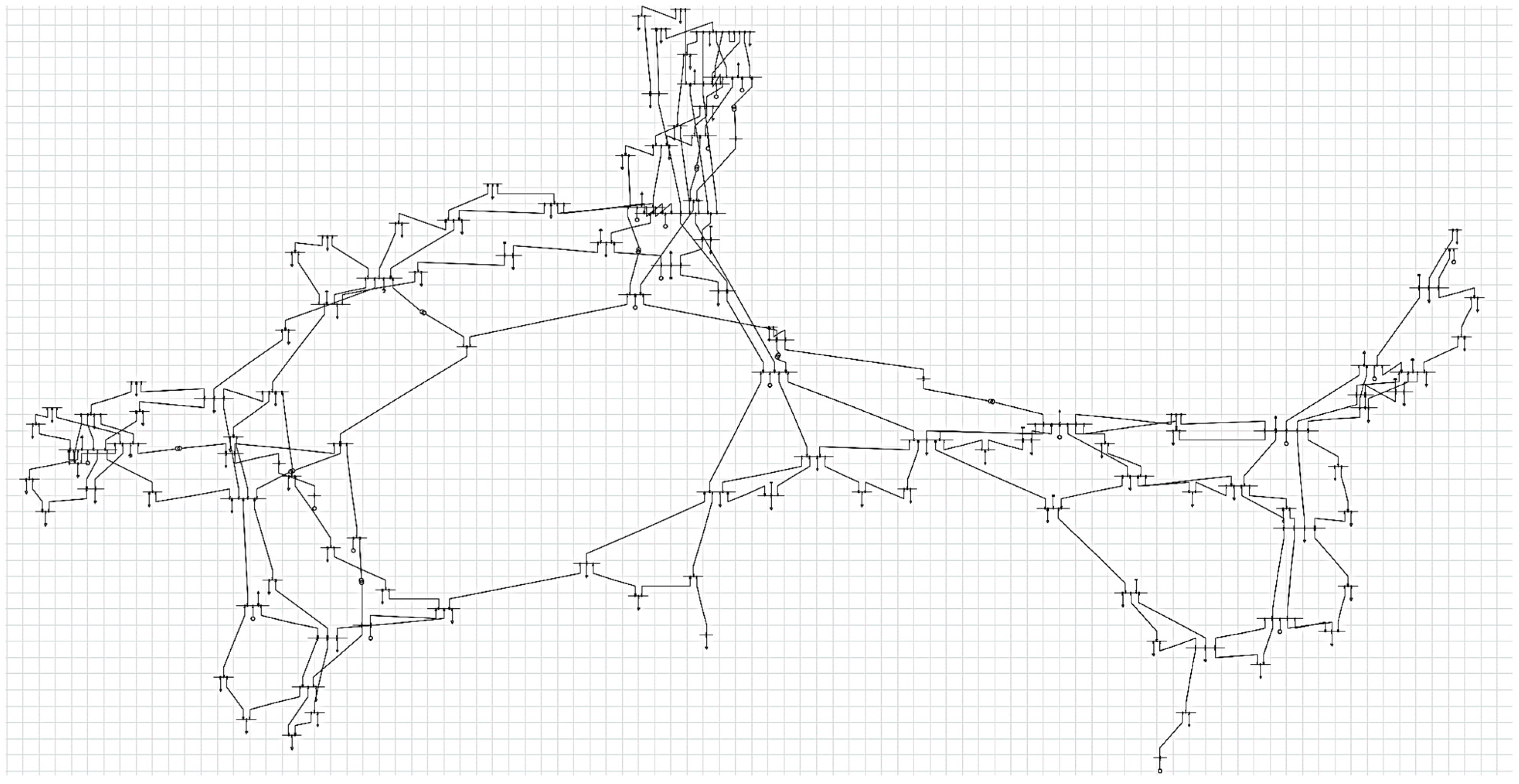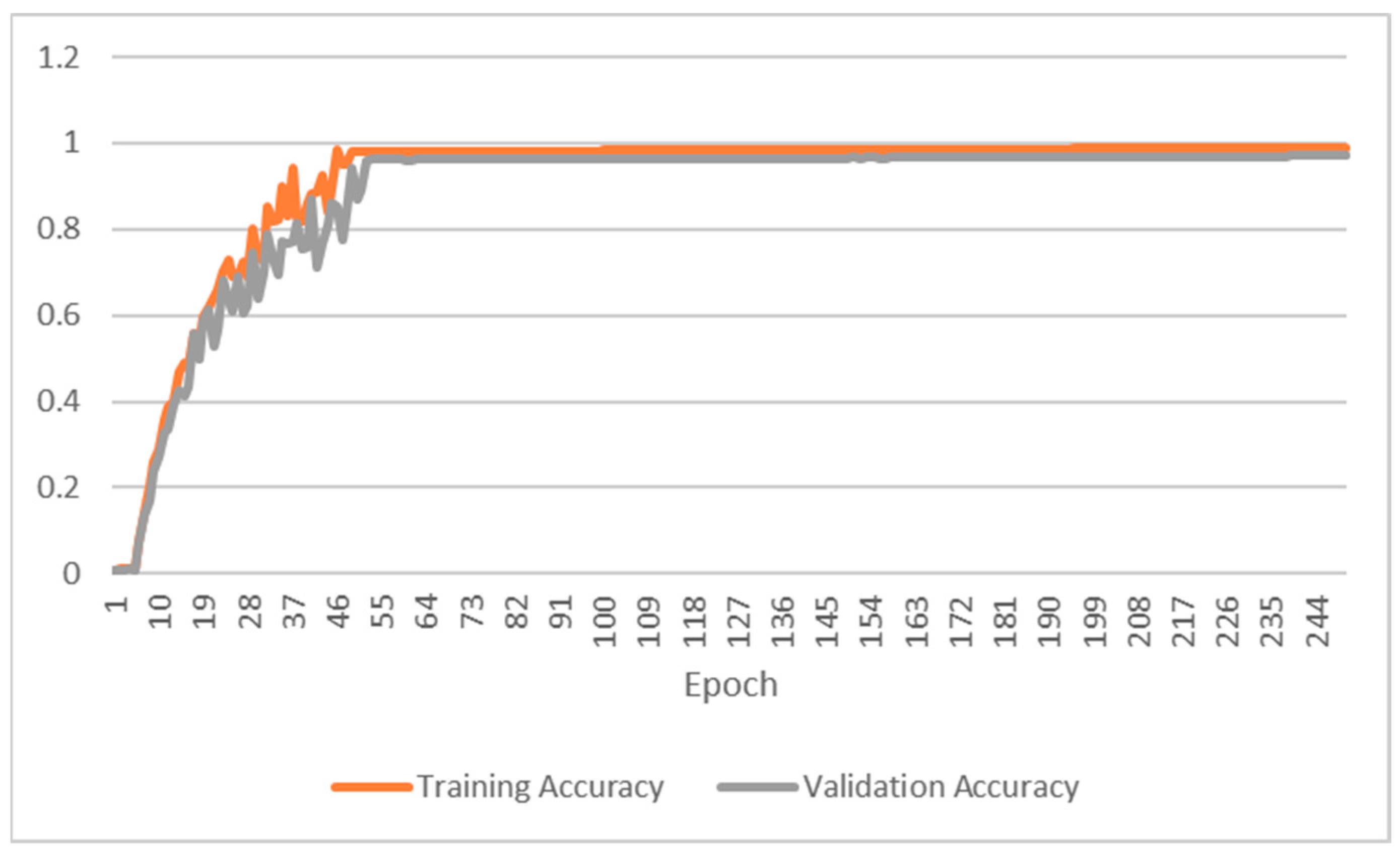Deep Learning-Based Dynamic State Estimation for Frequency Stability Monitoring in Power Systems with High Penetration of Renewable Generation †
Abstract
:1. Introduction
2. Dynamic State Estimation
- Prediction step at time step i−1 using (1) directly or through a set of points drawn from the probability distribution of the state estimate.
- Filtering/update step using (2). The predictions are used together with the measurements at time i to estimate the state vector and its covariance matrix.
- Improved model reliability for DSA [18];
- Enhanced oscillations monitoring by modal analysis by hierarchical and distributed DSE in small areas [19];
- Improved reliability of protection systems [20];
- Upgraded supervision of transient stability [21];
- Improved ROCOF evaluation [22];
- Failure detection in controllers [23], etc.
3. DSE in Frequency Monitoring
4. Proposed Methodology
5. ANN-Based FDE Classifier
- Learning rate: 0.0001,
- Number of epochs: 250,
- Optimizer: stochastic gradient-based Adam
- Dropout (to avoid overfitting): 0.5–0.8.
6. Results
7. Conclusions
Author Contributions
Funding
Institutional Review Board Statement
Informed Consent Statement
Data Availability Statement
Conflicts of Interest
References
- Monticelli, A. State Estimation in Electric Power Systems. A Generalized Approach; Springer: Berlin/Heidelberg, Germany, 1999. [Google Scholar]
- Liu, Y.; Singh, A.K.; Zhao, J.; Meliopoulos, A.S.; Pal, B.; bin Mohd Ariff, M.A.; Van Cutsem, T.; Glavic, M.; Huang, Z.; Kamwa, I.; et al. Dynamic State Estimation for Power System Control and Protection IEEE Task Force on Power System Dynamic State and Parameter Estimation. IEEE Trans. Power Syst. 2021, 36, 5909–5921. [Google Scholar] [CrossRef]
- Miller, W.L.; Lewis, J.B. Dynamic State Estimation in Power Systems. IEEE Trans. Automat. Contr. 1971, 16, 841–846. [Google Scholar] [CrossRef]
- Singh, A.K.; Pal, B.C. Rate of Change of Frequency Estimation for Power Systems Using Interpolated DFT and Kalman Filter. IEEE Trans. Power Syst. 2019, 34, 2509–2517. [Google Scholar] [CrossRef]
- Anagnostou, G.; Pal, B.C. Derivative-Free Kalman Filtering Based Approaches to Dynamic State Estimation for Power Systems with Unknown Inputs. IEEE Trans. Power Syst. 2017, 33, 116–130. [Google Scholar] [CrossRef]
- Afrasiabi, S.; Afrasiabi, M.; Rastegar, M.; Mohammadi, M.; Parang, B.; Ferdowsi, F. Ensemble Kalman Filter based Dynamic State Estimation of PMSG-based Wind Turbine. In Proceedings of the 2019 IEEE Texas Power and Energy Conference (TPEC), College Station, TX, USA, 7–8 February 2019; pp. 1–4. [Google Scholar] [CrossRef]
- Xie, W.; Huang, Z.; He, W.; Wang, K. A Square Root Cubature Kalman Filter Based Dynamic State Estimation of Distribution Network. In Proceedings of the 2020 IEEE/IAS Industrial and Commercial Power System Asia (I&CPS Asia), Weihai, China, 13–15 July 2020; pp. 497–501. [Google Scholar] [CrossRef]
- Sun, Z.; Chen, Y. Dynamic State Estimation of DFIG Using Square-Root Cubature Kalman Filter. In Proceedings of the 2021 IEEE 10th Data Driven Control and Learning Systems Conference (DDCLS), Suzhou, China, 14–16 May 2021; pp. 784–789. [Google Scholar] [CrossRef]
- Li, G.; Niu, D.; Song, E. A Multiple-Model State Estimator based on the Unscented Kalman Filter. In Proceedings of the 2020 39th Chinese Control Conference (CCC), Shenyang, China, 27–29 July 2020; pp. 3011–3016. [Google Scholar] [CrossRef]
- Sun, K.; Qi, J.; Kang, W. Power system observability and dynamic state estimation for stability monitoring using synchrophasor measurements. Control Eng. Pract. 2016, 53, 160–172. [Google Scholar] [CrossRef]
- Chowdhury, A.; Chatterjee, S.; Dey, A. Power Systems Dynamic State Estimation using Central Difference Filter. In Proceedings of the 2022 Second International Conference on Power, Control and Computing Technologies (ICPC2T), Raipur, India, 1–3 March 2022; pp. 1–6. [Google Scholar] [CrossRef]
- Cevallos, H.; Intriago, G.; Plaza, D. Performance of the Estimators Weighted Least Square, Extended Kalman Filter, and the Particle Filter in the Dynamic Estimation of State Variables of Electrical Power Systems. In Proceedings of the 2018 IEEE International Conference on Automation/XXIII Congress of the Chilean Association of Automatic Control (ICA-ACCA), Concepcion, Chile, 17–19 October 2018; pp. 1–6. [Google Scholar] [CrossRef]
- Liu, H.; Hu, F.; Su, J.; Wei, X.; Qin, R. Comparisons on Kalman-Filter-Based Dynamic State Estimation Algorithms of Power Systems. IEEE Access 2020, 8, 51035–51043. [Google Scholar] [CrossRef]
- Tian, G.; Zhou, Q.; Birari, R.; Qi, J.; Qu, Z. A Hybrid-Learning Algorithm for Online Dynamic State Estimation in Multimachine Power Systems. IEEE Trans. Neural Netw. Learn. Syst. 2020, 31, 5497–5508. [Google Scholar] [CrossRef] [PubMed]
- Akhlaghi, S.; Zhou, N.; Huang, Z. A Multi-Model Adaptive Kalman Filtering Approach to Power System Dynamic State Estimation. In Proceedings of the 2019 IEEE Power & Energy Society General Meeting (PESGM), Atlanta, GA, USA, 4–8 August 2019; pp. 1–5. [Google Scholar] [CrossRef]
- Cosic, S.; Vokony, I. Artificial Neural Networks—Based Method for Enhancing State Estimation of Grids with High Penetration of Renewables. Renew. Energy Power Qual. J. 2022, 20, 488–493. [Google Scholar] [CrossRef]
- Zhao, J.; Netto, M.; Huang, Z.; Yu, S.S.; Gómez-Expósito, A.; Wang, S.; Kamwa, I.; Akhlaghi, S.; Mili, L.; Terzija, V.; et al. Roles of dynamic state estimation in power system modeling, monitoring and operation. IEEE Trans. Power Syst. 2021, 36, 2462–2472. [Google Scholar] [CrossRef]
- Gotti, D.; Ledesma, P.; Amaris, H. Comparative Analysis between State Estimation Algorithms under Static and Dynamic Scenarios. In Proceedings of the 2020 IEEE International Conference on Environment and Electrical Engineering and 2020 IEEE Industrial and Commercial Power Systems Europe (EEEIC/I&CPS Europe), Madrid, Spain, 9–12 June 2020. [Google Scholar] [CrossRef]
- Chen, Y.; Huang, Z.; Jin, S.; Li, A. Computing for power system operation and planning: Then, now, and the future. iEnergy 2022, 1, 315–324. [Google Scholar] [CrossRef]
- Gotti, D.; Ledesma, P.; Amaris, H. A fast data-driven topology identification method for dynamic state estimation applications. Int. J. Electr. Power Energy Syst. 2023, 147, 108807. [Google Scholar] [CrossRef]
- Farantatos, E.; Huang, R.; Cokkinides, G.J.; Meliopoulos, A.P. A Predictive Generator Out-of-Step Protection and Transient Stability Monitoring Scheme Enabled by a Distributed Dynamic State Estimator. IEEE Trans. Power Deliv. 2016, 31, 1826–1835. [Google Scholar] [CrossRef]
- Zhao, J.; Tang, Y.; Terzija, V. Robust Online Estimation of Power System Center of Inertia Frequency. IEEE Trans. Power Syst. 2019, 34, 821–825. [Google Scholar] [CrossRef]
- Anagnostou, G.; Boem, F.; Kuenzel, S.; Pal, B.C.; Parisini, T. Observer-Based Anomaly Detection of Synchronous Generators for Power Systems Monitoring. IEEE Trans. Power Syst. 2018, 33, 4228–4237. [Google Scholar] [CrossRef]
- Sankaran, C. Power Quality; CRC Press: Boca Raton, FL, USA, 2017. [Google Scholar]
- Electricity Consumers Resource Council (ELCON). The Economic Impacts of the August 2003 Blackout. 2004. Available online: https://elcon.org/wp-content/uploads/Economic20Impacts20of20August20200320Blackout1.pdf (accessed on 17 July 2023).
- Coelho, R.d.A.; Brito, N.S.D. Power Measurement Using Stockwell Transform. IEEE Trans. Power Deliv. 2021, 36, 3091–3100. [Google Scholar] [CrossRef]
- Yadav, R.; Pradhan, A.K.; Kamwa, I. Real-Time Multiple Event Detection and Classification in Power System Using Signal Energy Transformations. IEEE Trans. Ind. Inform. 2019, 15, 1521–1531. [Google Scholar] [CrossRef]
- Sun, Z.; Liu, C.; Jiang, Q.; Levron, Y.; Cai, G. Evaluating generator damping for wind-integrated power system in ambient conditions. IET Renew. Power Gener. 2022, 16, 300–312. [Google Scholar] [CrossRef]
- Shadi, M.R.; Ameli, M.-T.; Azad, S. A real-time hierarchical framework for fault detection, classification, and location in power systems using PMUs data and deep learning. Int. J. Electr. Power Energy Syst. 2022, 134, 107399. [Google Scholar] [CrossRef]
- Lopes, G.V.d.S.; Moraes, G.R.; Issicaba, D.; Dotta, D. WAMS-based two-level robust detection methodology of power system events. Sustain. Energy Grids Netw. 2022, 31, 100689. [Google Scholar] [CrossRef]
- Sun, Z.; Ram, M.; Jiang, C.; Wang, Q.; Michael, P.; Juri, B.; Yoash, L. PF-FEDG: An open-source data generator for frequency disturbance event detection with deep-learning reference classifiers. Energy Rep. 2023, 9, 397–413. [Google Scholar] [CrossRef]





| Metrics | SSE | DSE |
|---|---|---|
| Measurement source | Conventional | PMU |
| Observability | Binary (yes/no) | Enhanced situation-dependent |
| Prediction update frequency | 1 snapshot per 2–10 s | 1 prediction + 1 filtering per 1/30 s |
| Load flow equations | Algebraic | Differential |
| Architecture | Centralized or distributed | Centralized and distributed |
| Output variables | Algebraic | Algebraic and dynamic |
| FDE Type | Number of Elements | Load Levels | Load Cases | Total Scenarios |
|---|---|---|---|---|
| G | 19 generators | 3 | 20 | 1140 |
| L | 99 loads | 3 | 4 | 1188 |
| F | 118 fault buses | 3 | 3 | 1062 |
| LO | 177 lines | 3 | 3 | 1593 |
| Input Variable | Accuracy of Sample Grid (%) | Accuracy of Modified Grid (%) |
|---|---|---|
| Frequency | 96.63 | 81.4 |
| ROCOF | 98.14 | 92.81 |
| Bus voltage magnitude | 98.37 | 84.37 |
| RAS | 92.58 | 71.33 |
Disclaimer/Publisher’s Note: The statements, opinions and data contained in all publications are solely those of the individual author(s) and contributor(s) and not of MDPI and/or the editor(s). MDPI and/or the editor(s) disclaim responsibility for any injury to people or property resulting from any ideas, methods, instructions or products referred to in the content. |
© 2023 by the authors. Licensee MDPI, Basel, Switzerland. This article is an open access article distributed under the terms and conditions of the Creative Commons Attribution (CC BY) license (https://creativecommons.org/licenses/by/4.0/).
Share and Cite
Ćosić, S.; Vokony, I. Deep Learning-Based Dynamic State Estimation for Frequency Stability Monitoring in Power Systems with High Penetration of Renewable Generation. Eng. Proc. 2023, 41, 16. https://doi.org/10.3390/engproc2023041016
Ćosić S, Vokony I. Deep Learning-Based Dynamic State Estimation for Frequency Stability Monitoring in Power Systems with High Penetration of Renewable Generation. Engineering Proceedings. 2023; 41(1):16. https://doi.org/10.3390/engproc2023041016
Chicago/Turabian StyleĆosić, Said, and István Vokony. 2023. "Deep Learning-Based Dynamic State Estimation for Frequency Stability Monitoring in Power Systems with High Penetration of Renewable Generation" Engineering Proceedings 41, no. 1: 16. https://doi.org/10.3390/engproc2023041016
APA StyleĆosić, S., & Vokony, I. (2023). Deep Learning-Based Dynamic State Estimation for Frequency Stability Monitoring in Power Systems with High Penetration of Renewable Generation. Engineering Proceedings, 41(1), 16. https://doi.org/10.3390/engproc2023041016






